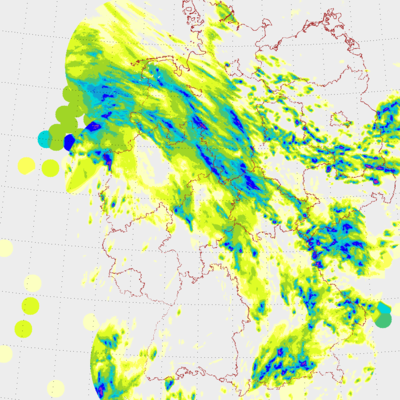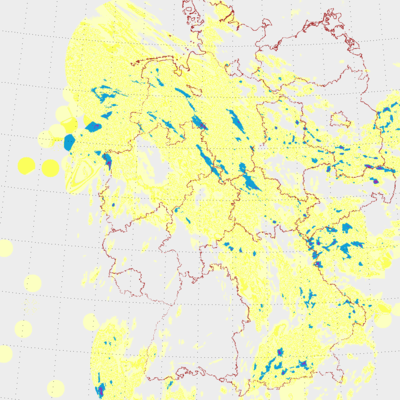Workdocumentation 2018-08-18
Jump to navigation
Jump to search
go
// rvp6LittleEndian converts the raw two byte tuple of little endian encoded composite products
// to radar video processor values (rvp-6). NaN may be returned when the no-data flag is set.
func (c *Composite) rvp6LittleEndian(tuple [2]byte) float32 {
var value int = 0x0F & int(tuple[1])
value = (value << 8) + int(tuple[0])
if tuple[1]&(1<<5) != 0 { // error code: no-data
return NaN
}
if tuple[1]&(1<<6) != 0 { // flag: negative value
value *= -1
}
conv := c.rvp6Raw(value) // set decimal point
// little endian encoded formats are also used for mm/h
if c.DataUnit != Unit_dBZ {
return conv
}
// Even though this format supports negative values and custom
// precision they do not make use of this and we still have to subtract
// the bias and scale it (RADVOR FX, dBZ)
return toDBZ(conv)
}
// rvp6Raw converts the raw value to radar video processor values (rvp-6) by applying the
// products precision field.
func (c *Composite) rvp6Raw(value int) float32 {
return float32(value) * float32(math.Pow10(c.precision))
}
Java
// rvp6LittleEndian converts the raw two byte tuple of little endian encoded
// composite products
// to radar video processor values (rvp-6). NaN may be returned when the
// no-data flag is set.
public static float rvp6LittleEndian(Composite c, byte... tuple) {
int value = 0x0F & tuple[1];
value = (value << 8) | (tuple[0]&0x0f);
if ((tuple[1] & (1 << 5)) != 0) { // error code: no-data
return Float.NaN;
}
if ((tuple[1] & (1 << 6)) != 0) { // flag: negative value
value *= -1;
}
float conv = (float) c.rvp6Raw(value); // set decimal point
// little endian encoded formats are also used for mm/h
if (c.getDataUnit() != Unit.Unit_dBZ) {
return conv;
}
// Even though this format supports negative values and custom
// precision they do not make use of this and we still have to subtract
// the bias and scale it (RADVOR FX, dBZ)
return Conversion.toDBZ(conv);
}
// rvp6Raw converts the raw value to radar video processor values (rvp-6) by applying the
// products precision field.
public static double rvp6Raw(Composite c, int value) {
double rvalue=value * c.getPrecisionFactor();
return rvalue;
}
Difference Examples
first column: Java - second column: go
484, 0: 0,0 != 1,6 484, 1: 0,0 != 1,6 485, 1: 0,4 != 2,0 486, 1: 0,0 != 1,6 487, 1: 0,0 != 1,6 484, 2: 0,0 != 1,6 485, 2: 0,7 != 2,3 486, 2: 0,8 != 2,4 487, 2: 0,4 != 2,0 488, 2: 0,1 != 1,7 485, 3: 0,4 != 2,0 486, 3: 0,8 != 2,4 487, 3: 1,3 != 2,9 489, 3: 0,1 != 1,7 490, 3: 0,1 != 1,7 242, 4: 0,0 != 1,6 243, 4: 0,2 != 1,8 485, 4: 0,0 != 1,6 486, 4: 0,3 != 1,9 487, 4: 0,5 != 2,1 488, 4: 1,4 != 3,0 489, 4: 1,3 != 2,9 490, 4: 1,3 != 2,9 491, 4: 0,8 != 2,4 492, 4: 0,1 != 1,7 240, 5: 0,9 != 2,5 241, 5: 0,8 != 2,4 242, 5: 0,2 != 1,8 244, 5: 0,0 != 1,6 486, 5: 0,5 != 2,1 487, 5: 0,4 != 3,6 488, 5: 0,6 != 3,8 489, 5: 0,1 != 4,9 490, 5: 1,2 != 4,4 491, 5: 0,4 != 3,6 492, 5: 1,5 != 3,1 493, 5: 0,7 != 2,3 500, 5: 0,1 != 1,7 501, 5: 0,1 != 1,7 238, 6: 1,4 != 3,0 239, 6: 0,8 != 2,4 240, 6: 0,6 != 2,2 241, 6: 0,3 != 1,9 244, 6: 0,1 != 1,7 245, 6: 0,2 != 1,8 246, 6: 0,1 != 1,7 486, 6: 0,9 != 2,5 487, 6: 0,9 != 4,1 488, 6: 0,6 != 3,8

